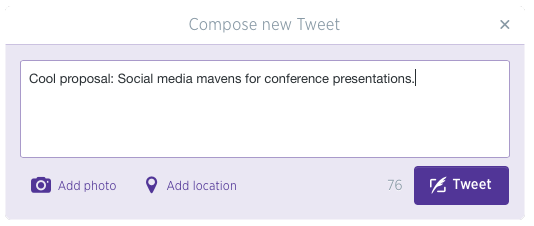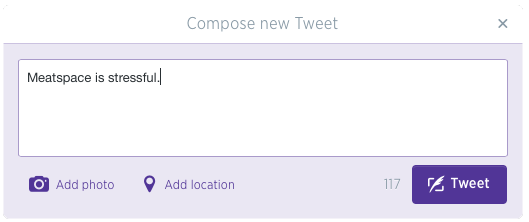Tweet
Just got back from two cool conferences: Rhetoric Society of America Conference and  Computers and Writing Conference. Learned a lot about rhetoric and humor from @cateblouke; rhetoric and algorithms from @johnmjones & @jaykirby1; rhetoric and reproduction from @lbdehertogh, @kristinarola, & @maseigel; and learned about Google glass from @Zombieranian – even got to try them out, which was really cool.
Computers and Writing Conference. Learned a lot about rhetoric and humor from @cateblouke; rhetoric and algorithms from @johnmjones & @jaykirby1; rhetoric and reproduction from @lbdehertogh, @kristinarola, & @maseigel; and learned about Google glass from @Zombieranian – even got to try them out, which was really cool.
By “cool” I mean the presentations were thoughtful and engaging. In other words, I thought about things I ain’t never thought before. Besides the thoughtful and engaging presentations, another cool of the conferences came from the Twitter backchannels (#RSA14 and #CWCON) for discussin’, commentin’, and quotin’ presentations. In other words, I participated in ways I ain’t never done before because of my meatspace phobia and my lack of short term memory.
Though there was a lotta cool, there was one part of the conferences that was discool, uncool, or non-cool: the Twitter backchannel was rarely incorporated into the meatspace or live discussion following the presentations. Sorta made me feel like my participation was ignored. So I’d like to propose this cool idea for future conferences, though I’m not sure if it is possible or if there is an infrastructure for it:

Cool proposal: Social media mavens for conference presentations.
What I mean is, I think it would be cool, in addition to having a presentation chair, to have a social media maven who monitors and participates in the Twitter backchannel of presentations.
Here’s why it’s cool –
- Cook meatspace phobias – A maven can help bring the virtual conversations, comments, and questions, which are real conversations, comments,and questions into discussions following presentations for those with meatspace phobias. A Twitter backchannel is inclusive for those, like me, who don’t want to face-to-face and feel
 extreme stress (especially f starting conversations or discussions) when participating in discussions following presentations. The Twitter backchannel provides access to discussion for those with such fears.
extreme stress (especially f starting conversations or discussions) when participating in discussions following presentations. The Twitter backchannel provides access to discussion for those with such fears. - Honor the social media skill set – Having a social media maven monitor the Twitter backchannel will honor social media expertise – of collecting, reading, and synthesizing ideas quickly and getting a bead, a feel, the gist of backchannel questions and comments. A maven will even be able to add this to his/her CV.
- Include the online audience – A maven would ensure that ideas are “voiced” from audiences attending the conference online who are following social media conversations, comments, and questions through a Twitter backchannel.
- Remember in the moment – A maven is mnemonic. A Twitter backchannel is a
 pretty public recording device that helps us remember the fleeting nature of oral presentations. And a lotta times, it seems like the last presenter’s work is discussed the most because it’s remembered. During an oral presentation, an audience may forget what was said (even in the most engaging presentations) when it was said and the context of what was said when. Backchanneling lets an audience converse, comment, and question a presentation in the moment. It allows presenters to record and share a thought before forgetting the thought they thinked at the time they thinked it.
pretty public recording device that helps us remember the fleeting nature of oral presentations. And a lotta times, it seems like the last presenter’s work is discussed the most because it’s remembered. During an oral presentation, an audience may forget what was said (even in the most engaging presentations) when it was said and the context of what was said when. Backchanneling lets an audience converse, comment, and question a presentation in the moment. It allows presenters to record and share a thought before forgetting the thought they thinked at the time they thinked it. - Take the pressure off chairs and presenters – A maven could take the pressure off of chairs and presenters to monitor the backchannel. During a presentation, the chair and other members of panels are understandably preoccupied with their performances. They may not have time or the skill set to respond to the Twitter backchannel. Though it can be done as @jennykorn showed in her savvy inclusion of Twitter backchannel conversations, comments, and questions, I know, however, this is really tough to do and I ain’t got the ability cuz I tried when I presented and #failed.
- Remove the #awkward – A maven could open up dialogue and crack the conversational seal that happens following presentations during the 15 minutes of discussion. You know, that awkward pause that occurs when a chair asks, “Are there any questions?” At this point, I usually look at my phone or laptop because I feel like I’m gonna be called since the presentation format is so lecture, school like. Conversely, when I present as a chair and ask that klutzy question, it feels like an awkward forever. If there isn’t a discussion because the room is full of meatspace phones like me or there is a looooong moment before questions, I feel sorta sad. The performance becomes out of sync, and I get the feeling my ideas weren’t really worth anything. All the time I spent on my presentation was wasted. Feedback is love even if it’s critical. Seriously.
“Social Media Maven” may not be the coolest word for the addition I am proposing to presentation formats, but the idea has some cool, right?

I really like this idea – at Illinois State, we’re planning our grad student conference for next spring, and I’d like to incorporate something like this as a way to draw in more questions from the undergraduates who attend. Do you think it would work to maybe have a designed “Twitter Maven” sitting in on each panel, maybe someone who could sort through the Twitter posts for patterns of questions that need to be brought up?
On the plus side, I think that many undergrads might be more comfortable typing out their questions rather than speaking up, but I’m worried that some panelists might interpret the use of devices as texting or chatting outside the conference space. Any ideas on preventing digital disconnection while bridging the digital and in-person spaces?
HeyheyRyan,
I think that’s a great idea. It’d be really cool, too, if you had two screens or a split screen so the audience could read the discussion generated in Twitter while the presentation was going on.
And, boy, I’m not sure how to bridge the two cultures of audience participation you mention. It’s funny but now when I present at conferences and too many people are making eye contact with me I think, “Damn. My presentation must be pretty lame.” I sorta want to see people in the audience texting or staring at their devices and typing.
Lemme know how it goes and good luck!